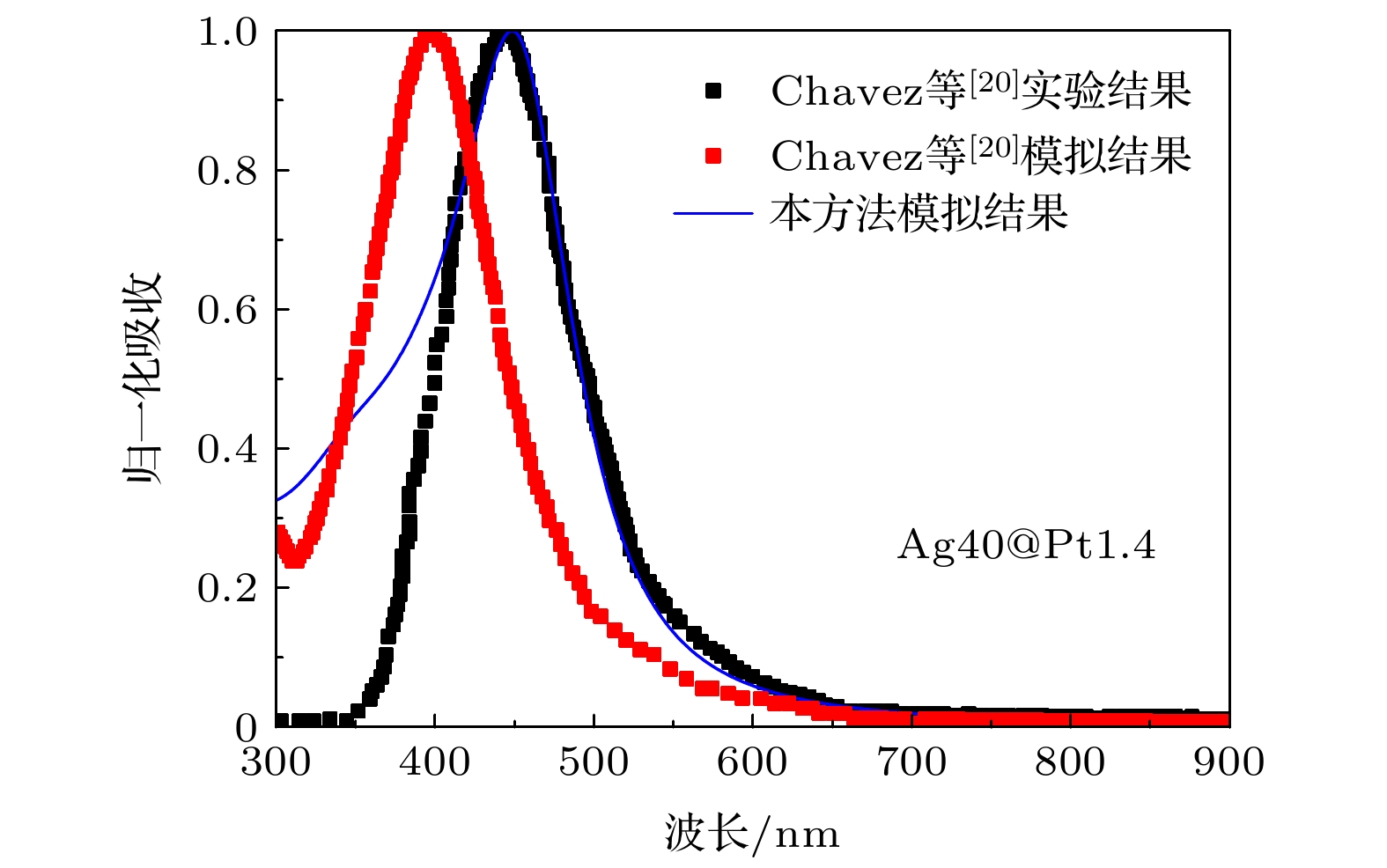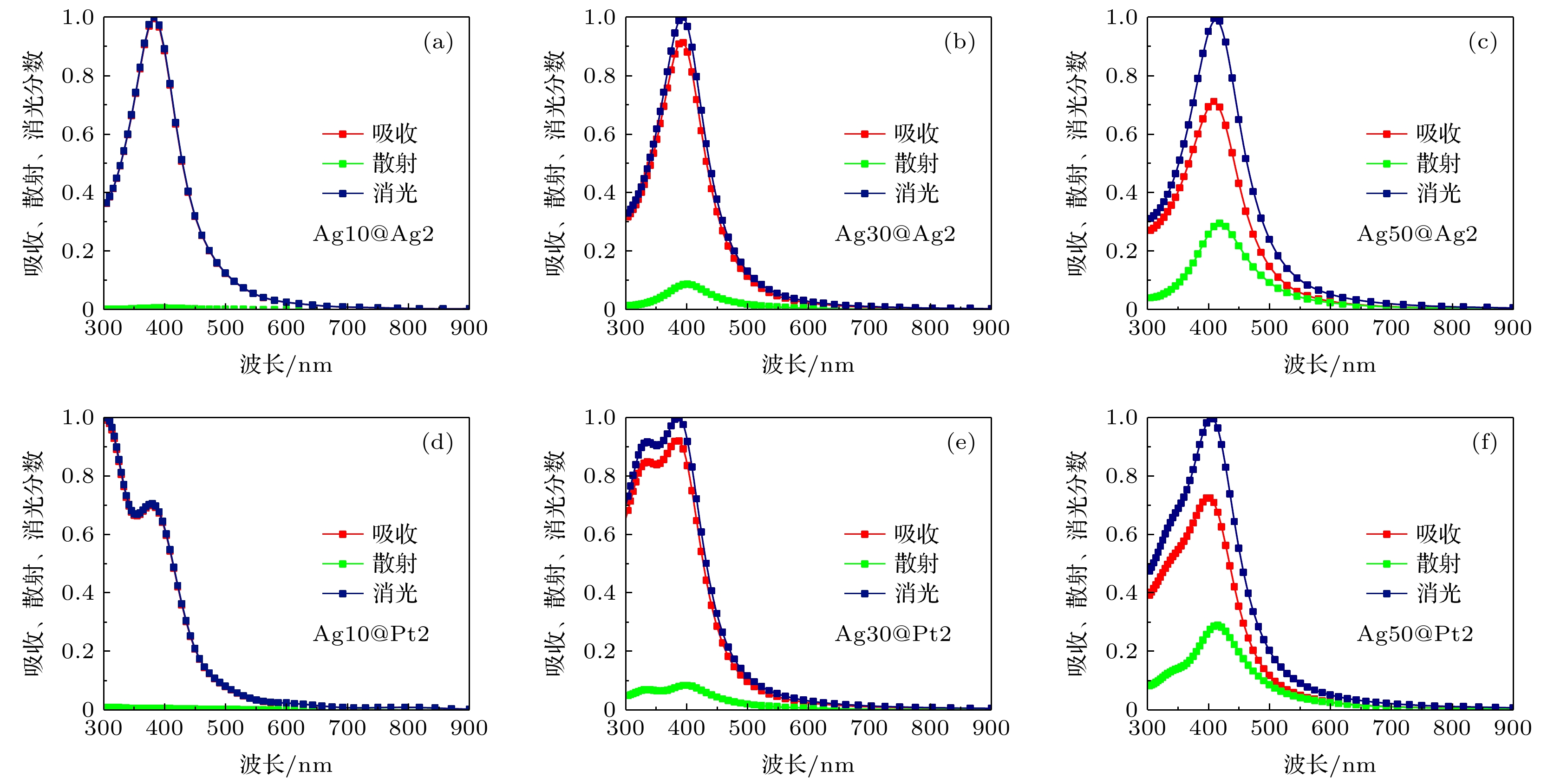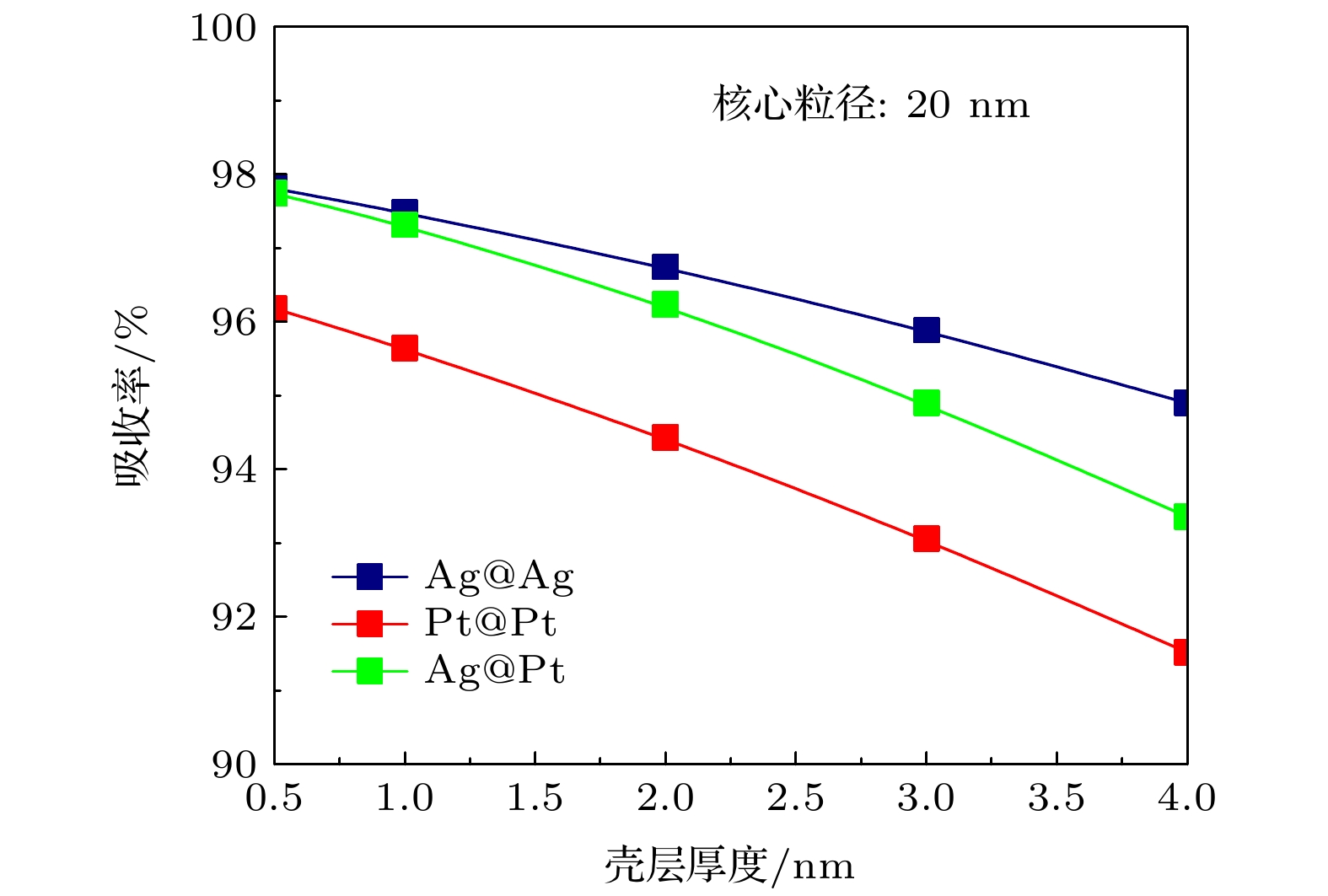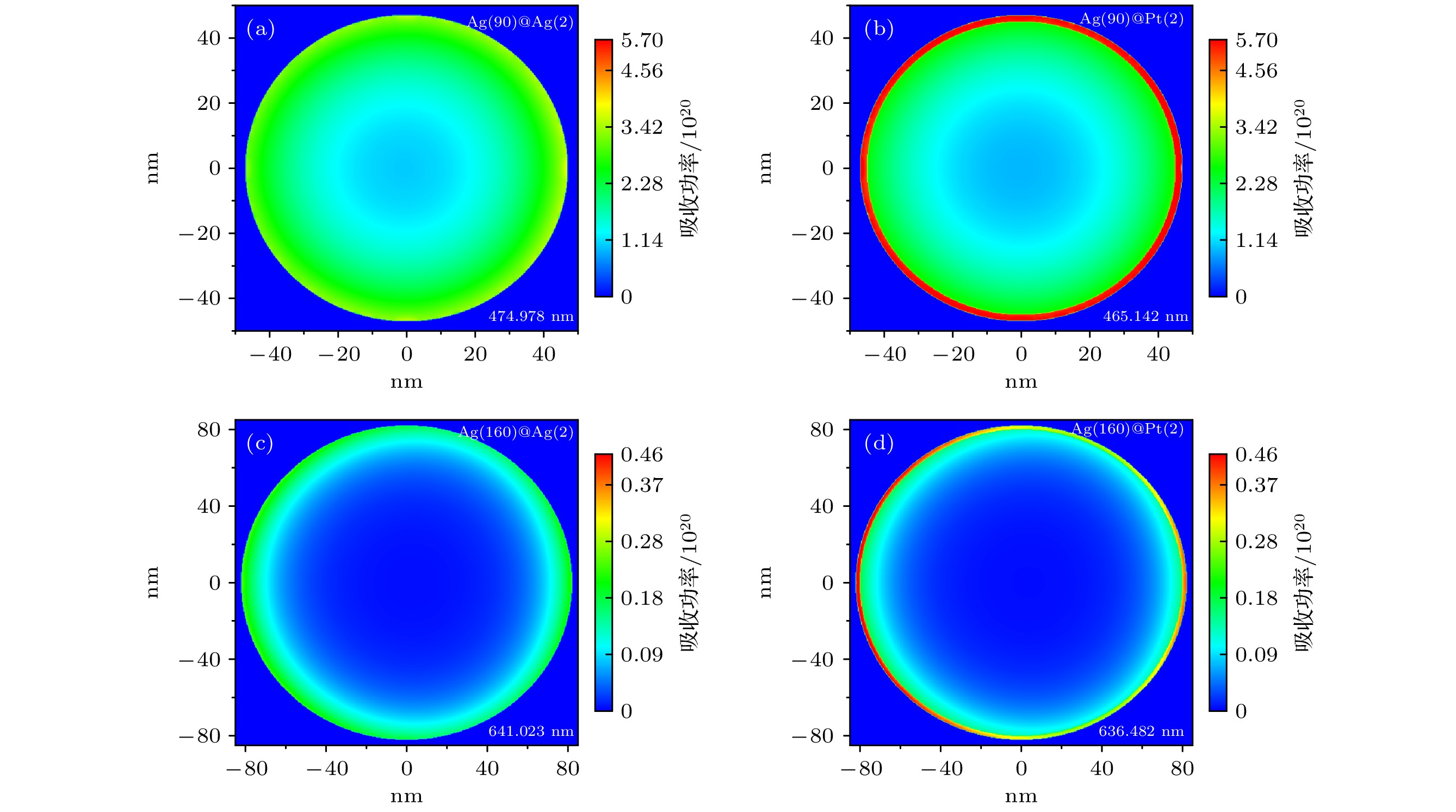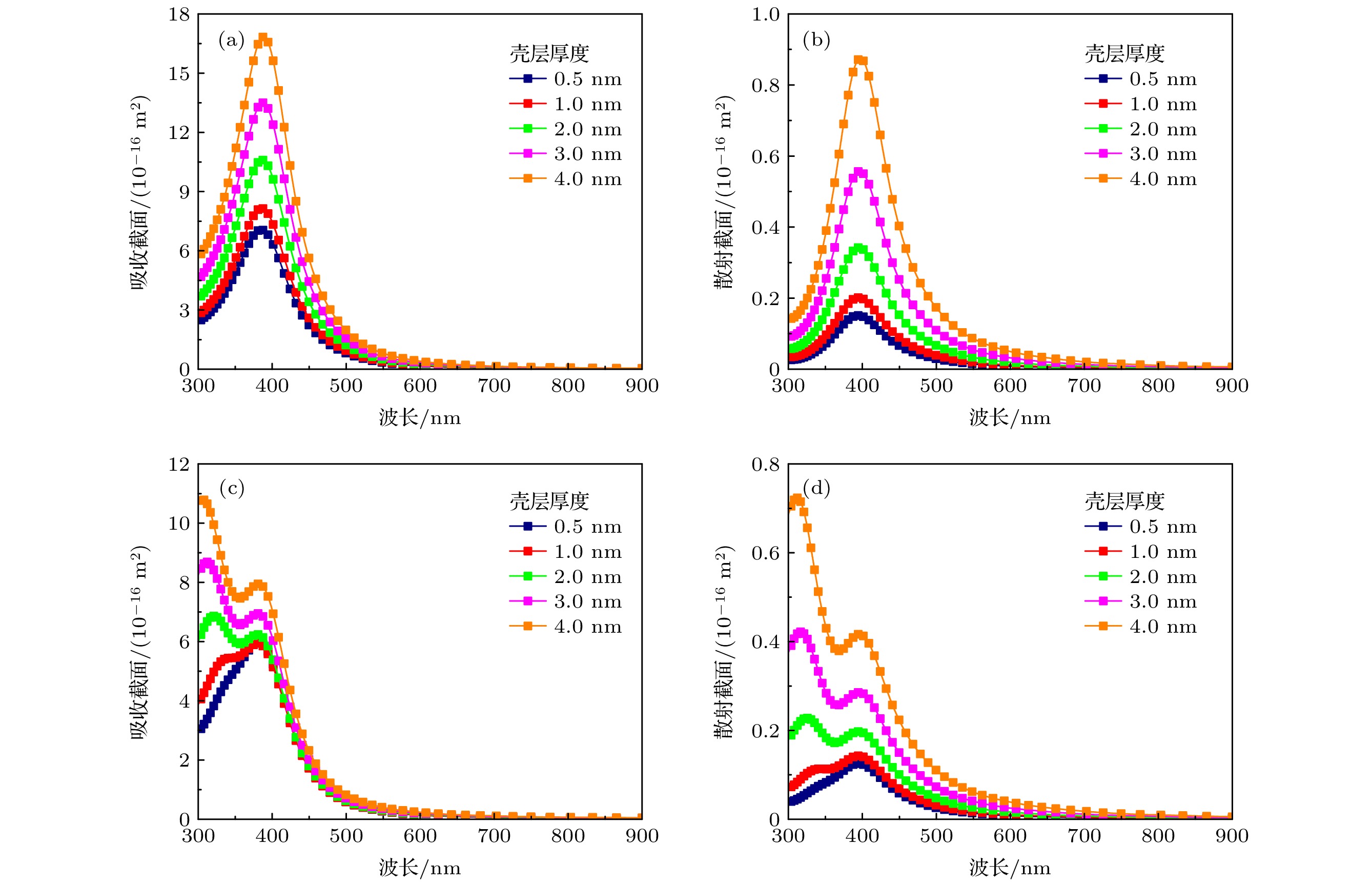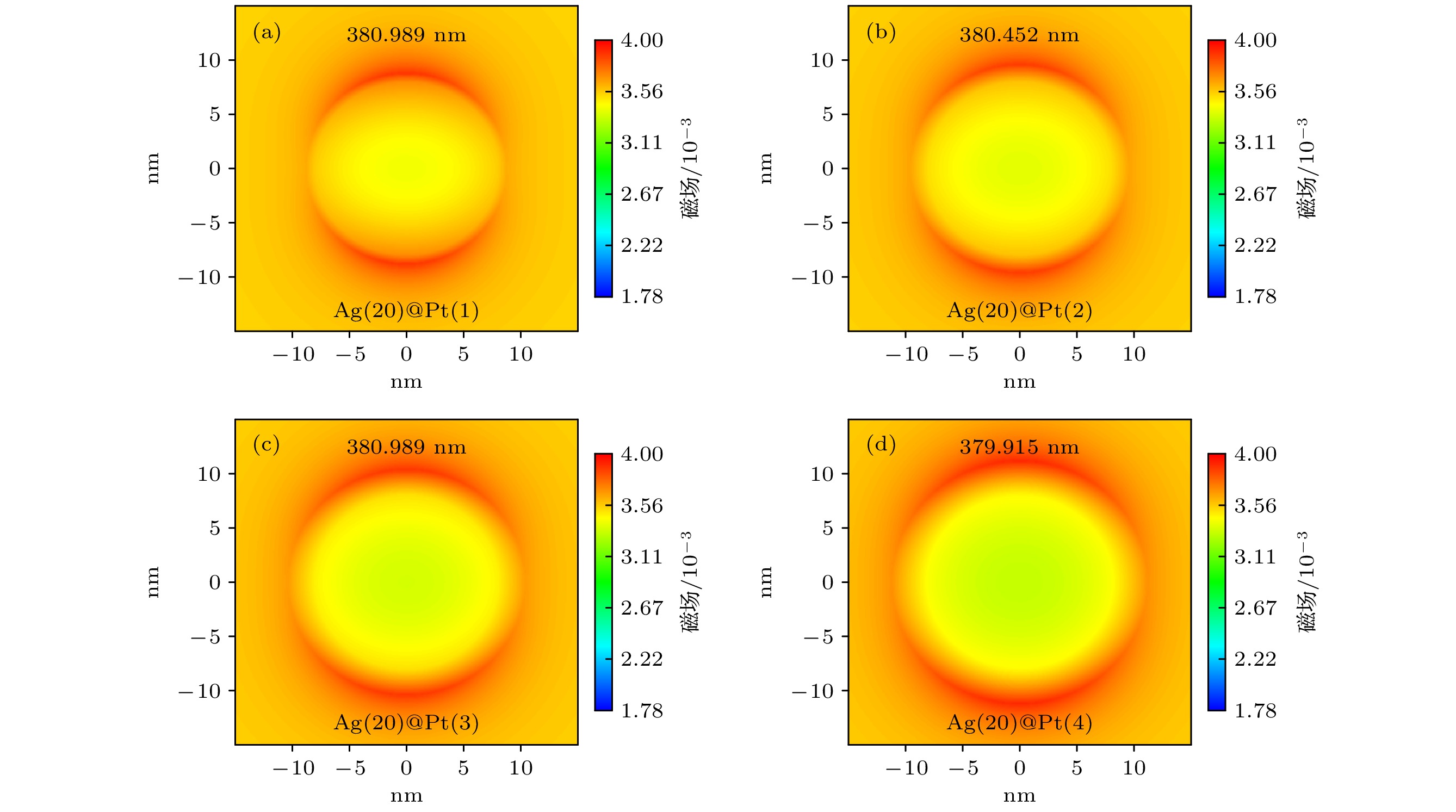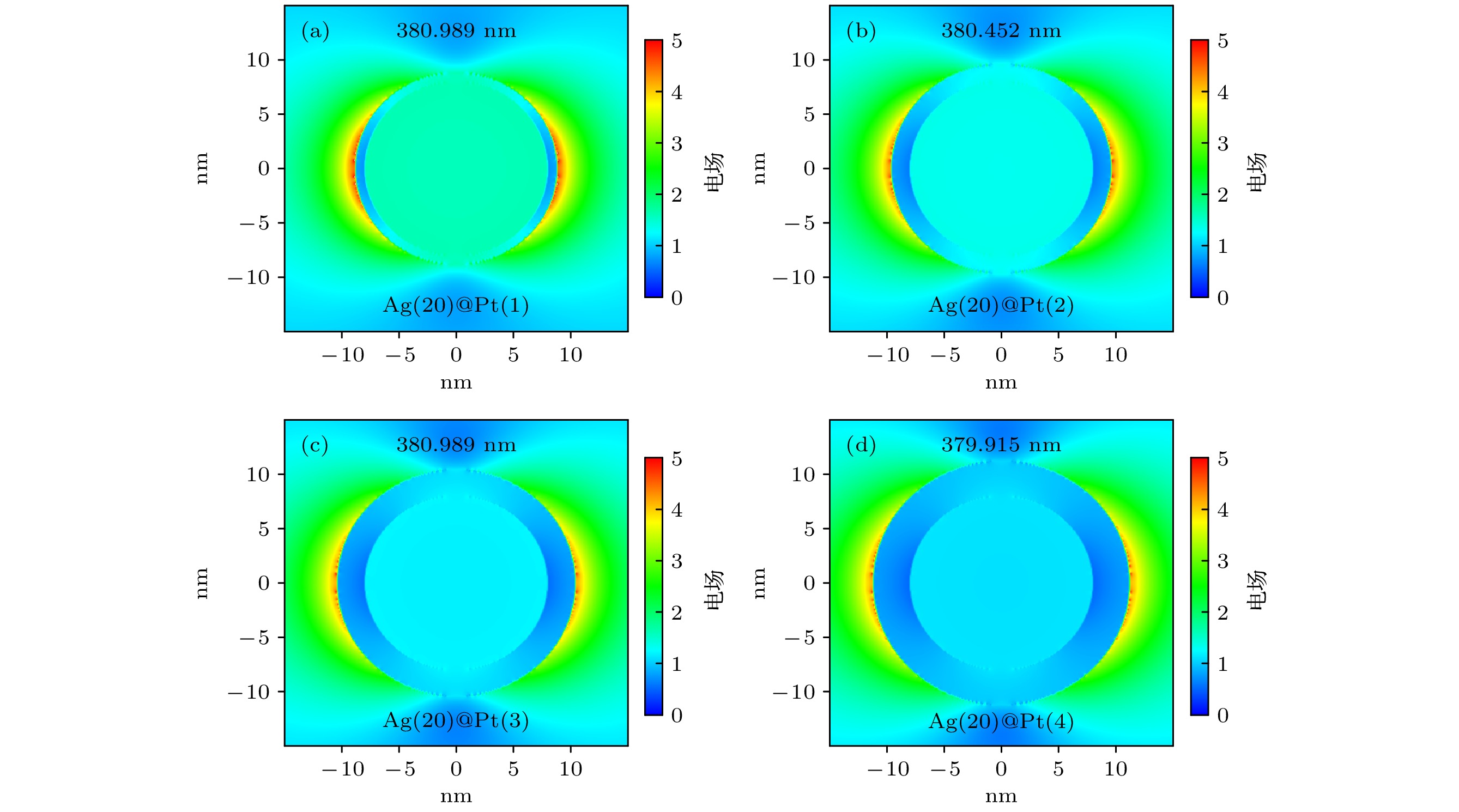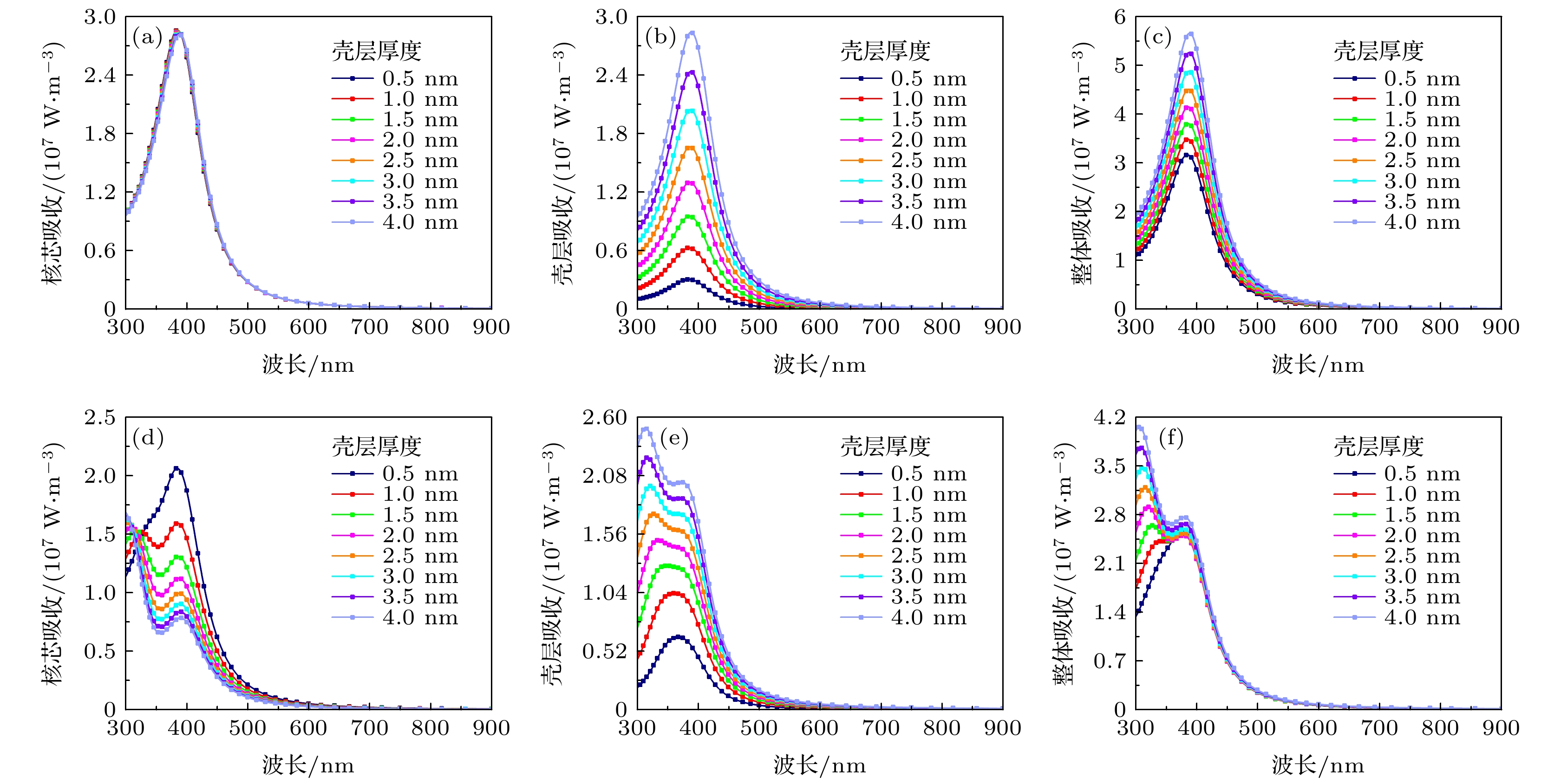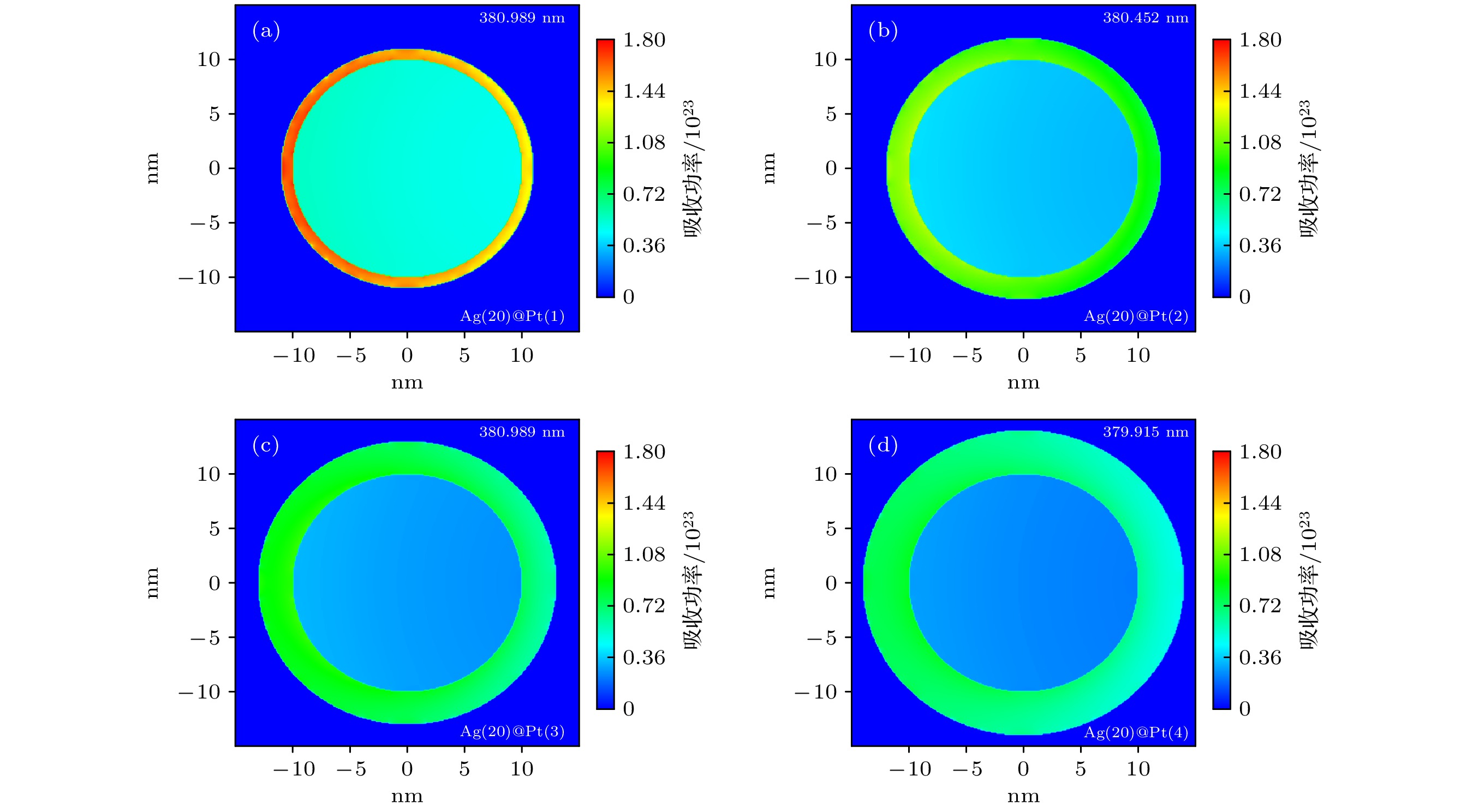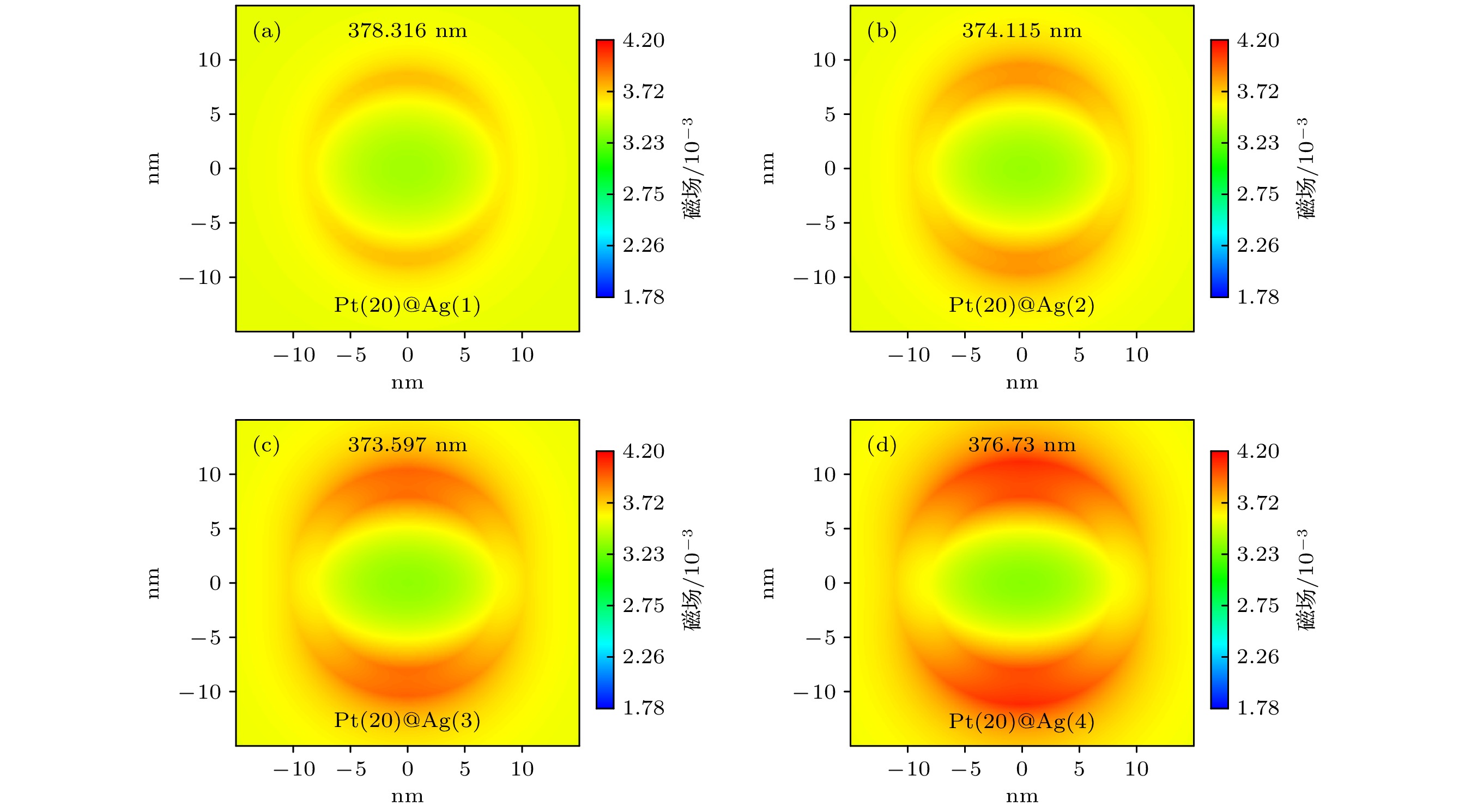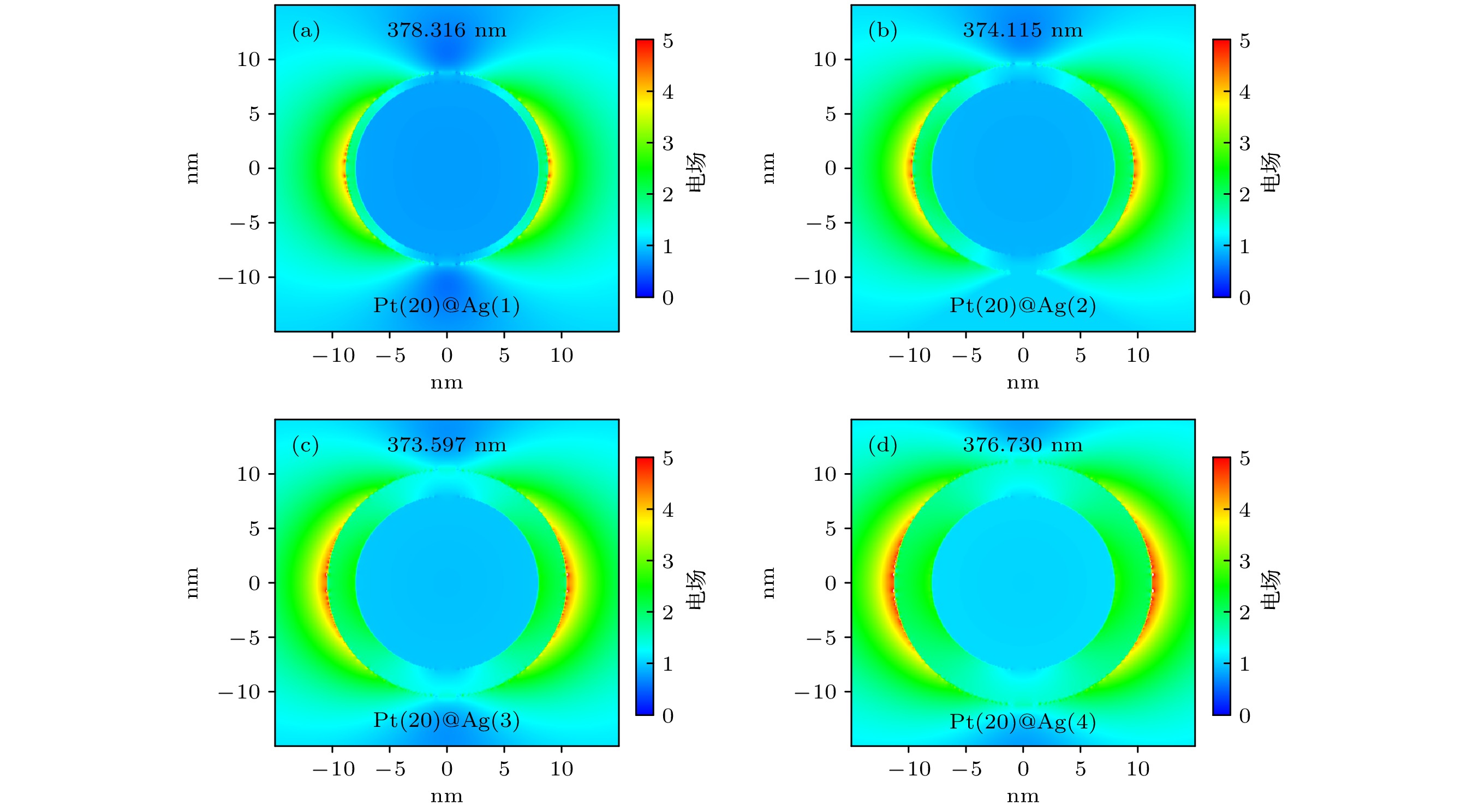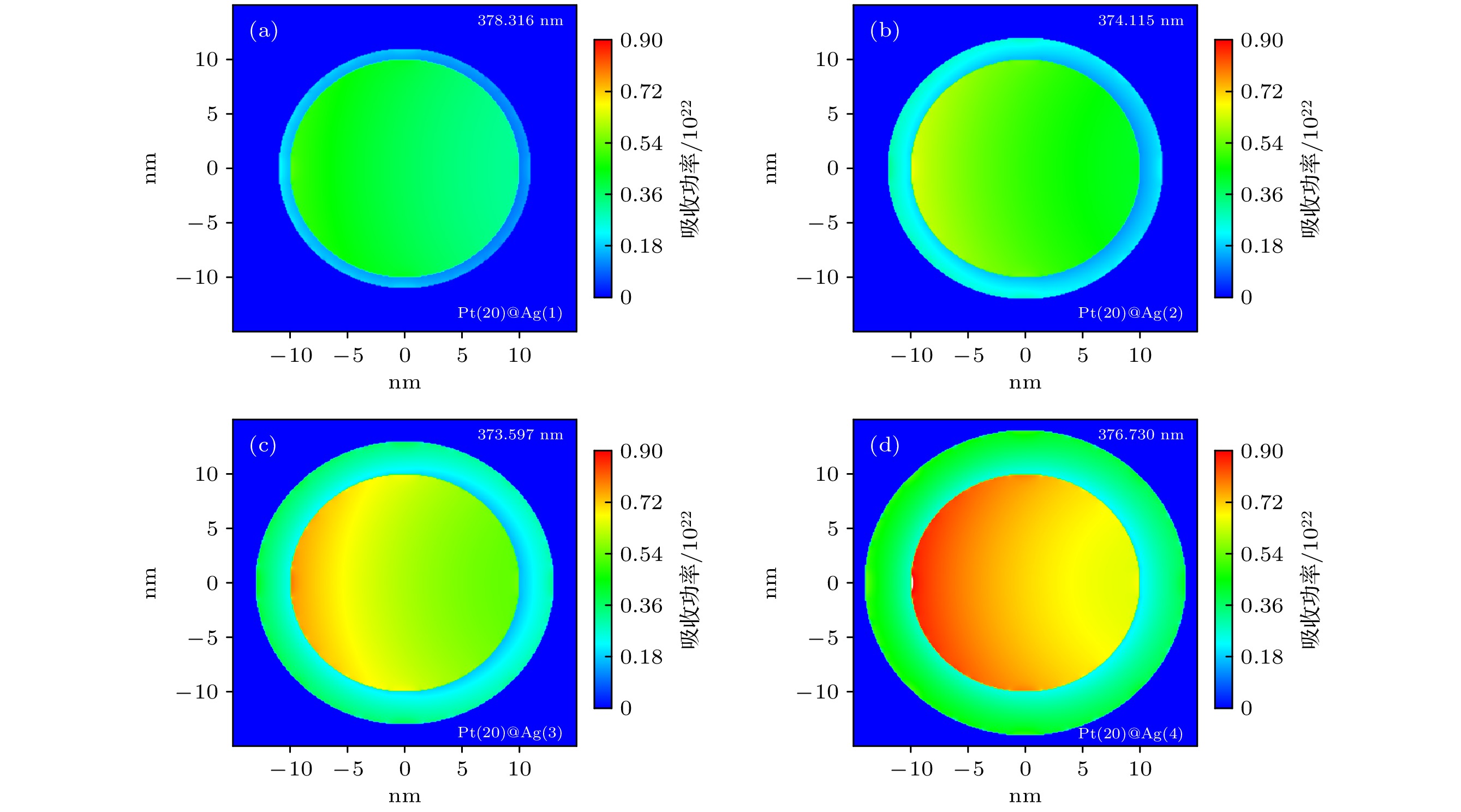-
双金属纳米颗粒能够有效整合两种金属的物理和化学性质并同时表达每种金属的独特性质, 是提高光散射、光热转换、等离激元共振衰变和光子激发的重要材料. 基于单独纳米颗粒的研究可以避免实验研究过程中纳米颗粒之间的相互影响, 更能够有效分析入射光与纳米颗粒之间的相互作用. 本文采用时域有限差分法计算了等离激元双金属核壳纳米颗粒的光谱学性能和能量传递衰减过程中的磁场、电场及吸收功率分布, 以探讨其光谱吸收特性. 结果表明, 随着核芯粒径的增大, 共振波长红移, 当核芯粒径大于100 nm时, Ag@Pt双金属纳米颗粒吸收率高于纯金属纳米颗粒, 这是由于壳层与核芯金属材料之间强烈的屏蔽效应使入射光仅与外层原子相互作用发生共振. 同时, 相对于Pt壳层而言, Ag核芯等离激元衰减更快, 因此更多的能量转移到了Pt壳中, 使Pt壳表面的磁场、电场较为集中且吸收功率较大. 此外, Ag核芯中的能量更趋向于向邻近Pt壳转移, 表现为靠近Ag核芯的区域能量吸收更为集中. 本文为设计满足特定光谱响应需求的等离激元核壳结构双金属纳米颗粒提供了理论指导.The bimetallic nanoparticle can effectively integrate the physical and chemical properties of two metals and simultaneously exhibits the unique natures of each metal. It also serves as a good candidate for improving light scattering, photothermal conversion, plasmon resonance decay, and photon excitation. Investigating the optical properties of an individual nanoparticle can avoid the interaction between nanoparticles during experimental research, which allows us to more effectively analyze the interaction between the incident light and nanoparticles. In this work, the finite-difference time-domain method is used to study the spectral absorption characteristics of the plasmon bimetallic core-shell nanoparticles by calculating the spectroscopic properties, and also the distributions of the magnetic field, electric field, and absorption power during energy transmission and decaying. The results show that the resonance wavelength is red-shifted if the core diameter is increased. In addition, the absorption rate of Ag@Pt bimetallic nanoparticles is higher than that of pure Ag@Ag nanoparticles when the core diameter is bigger than 100 nm. This is because the strong shielding effect between the shell metal material and the core metal material leads the incident light to interact only with the outer atoms, resulting in resonance. Meanwhile, the plasmon of the Ag core decays faster than that of the Pt shell and more energies are transferred to the Pt shell. As a result, the surface of the Pt shell shows more concentrated magnetic and electric fields associated with an enlarged absorbing power. Moreover, the energy in the Ag core tends to transfer to the nearby Pt shell, which is characterized by the energy absorption in the Pt shell close to the Ag core, and is more concentrated. This paper provides theoretical guidance for designing plasmon bimetallic core-shell nanoparticles, thereby satisfying the demands for special spectral responses.
-
Keywords:
- solar energy conversion /
- core-shell structure /
- bimetallic nanoparticles /
- spectral absorption inversion
[1] Cao C, Zhao Z Y, Zhang Y M, Peng S 2020 J. Phys. D: Appl. Phys. 53 265103
 Google Scholar
Google Scholar
[2] 刘海舟, 喻小强, 李金磊, 徐凝, 周林, 朱嘉 2019 中国科学: 物理学 力学 天文学 49 17
 Google Scholar
Google Scholar
Liu H Z, Yu X Q, Li J L, Xu N, Zhou L, Zhu J 2019 Sci China: Phys. Mech. Astron. 49 17
 Google Scholar
Google Scholar
[3] Kunwar S, Pandit S, Jeong J H, Lee J 2020 Nano-Micro Lett. 12 91
[4] 任益弘, 朱君, 李娜, 王各, 娄健 2020 激光杂志 41 1
 Google Scholar
Google Scholar
Ren Y H, Zhu J, Li N, Wang G, Lou J 2020 Laser J. 41 1
 Google Scholar
Google Scholar
[5] Wang T M, Tang G H, Du M 2020 Appl. Therm. Eng. 173 115182
 Google Scholar
Google Scholar
[6] 殷澄, 陆成杰, 笪婧, 张瑞耕, 阚雪芬, 韩庆邦, 许田 2021 物理学报 70 024201
 Google Scholar
Google Scholar
Yin C, Lu C J, Da J, Zhang R G, Kan X F, Han Q B, Xu T 2021 Acta Phys. Sin. 70 024201
 Google Scholar
Google Scholar
[7] 彭浩程, 葛成, 周婧, 陈鹏, 施毅, 张荣, 郑有炓 2020 光电子技术 40 176
 Google Scholar
Google Scholar
Peng H C, Ge C, Zhou J, Chen P, Shi Y, Zhang R, Zheng Y L 2020 Optoe. Technol. 40 176
 Google Scholar
Google Scholar
[8] Chen M J, He Y R, Wang X Z, Hu Y W 2018 Appl. Energy 211 735
 Google Scholar
Google Scholar
[9] Tunkara E, DeJarnette D, Saunders A E, Baldwin M, Otanicar T, Roberts K P 2019 Appl. Energy 252 113459
 Google Scholar
Google Scholar
[10] Yu X X, Xuan Y M 2018 Sol. Energy 160 200
 Google Scholar
Google Scholar
[11] 刘兵, 宫辉力, 刘锐, 胡长文 2019 应用化学 36 939
 Google Scholar
Google Scholar
Liu B, Gong H L, Liu R, Hu C W 2019 Chin. J. Appl. Chem. 36 939
 Google Scholar
Google Scholar
[12] 朱群志, 蒋瑜毅 2017 光散射学报 29 222
 Google Scholar
Google Scholar
Zhu Q Z, Jiang Y Y 2017 Chin. J. Light Scatt. 29 222
 Google Scholar
Google Scholar
[13] Manjavacas A, Liu J G, Kulkarni V, Nordlander P 2014 ACS Nano 8 7630
 Google Scholar
Google Scholar
[14] Linic S, Aslam U, Boerigter C, Morabito M 2015 Nat. Mater. 14 567
 Google Scholar
Google Scholar
[15] 朱旭鹏, 石惠民, 张轼, 陈智全, 郑梦洁, 王雅思, 薛书文, 张军, 段辉高 2019 物理学报 68 147304
 Google Scholar
Google Scholar
Zhu X P, Shi H M, Zhang S, Chen Z Q, Zheng M J, Wang Y S, Xue S W, Zhang J, Duan H G 2019 Acta Phys. Sin. 68 147304
 Google Scholar
Google Scholar
[16] 林丹丽, 董旭, 查刘生 2018 分析测试学报 37 599
 Google Scholar
Google Scholar
Lin D L, Dong X, Zha L S 2018 J. Instr. Anal. 37 599
 Google Scholar
Google Scholar
[17] Chavez S, Aslam U, Linic S 2018 ACS Energy Lett. 3 1590
 Google Scholar
Google Scholar
[18] Yee K S 1966 IEEE Trans. Antennas Propag. 14 302
 Google Scholar
Google Scholar
[19] Werner W S M, Glantschnig K, Ambroschdraxl C 2009 J. Phys. Chem. Ref. Data 38 1013
 Google Scholar
Google Scholar
-
图 4 壳层厚度为2 nm时不同核芯粒径纳米颗粒的吸收、散射和消光分数 (a) R = 10 nm, (b) R = 30 nm和(c) R = 50 nm的Ag@Ag纳米颗粒; (d) R = 10 nm, (e) R = 30 nm和(f) R = 50 nm的Ag@Pt纳米颗粒
Fig. 4. Absorption, scattering, and extinction fraction of nanoparticles with a shell thickness of 2 nm and different core sizes: Ag@Ag nanoparticle with (a) R = 10 nm, (b) R = 30 nm, and (c) R = 50 nm; Ag@Pt nanoparticle with (d) R = 10 nm, (e) R = 30 nm, and (f) R = 50 nm.
图 6 壳层厚度为2 nm时不同核芯粒径纳米颗粒吸收功率分布 (a) R = 90 nm的Ag@Ag纳米颗粒; (b) R = 90 nm的Ag@Pt纳米颗粒; (c) R = 160 nm的Ag@Ag纳米颗粒; (d) R = 160 nm的Ag@Pt纳米颗粒
Fig. 6. Power absorption distributions of nanoparticles with a shell thickness of 2 nm and different core sizes: (a) Ag@Ag, (b) Ag@Pt nanoparticles with R = 90 nm; (c) Ag@Ag, (d) Ag@Pt nanoparticles with R = 160 nm.
图 7 核芯粒径为20 nm时不同壳层厚度(0.5—4.0 nm)纳米颗粒光学特性 (a) Ag@Ag纳米颗粒吸收截面; (b) Ag@Ag纳米颗粒散射截面; (c) Ag@Pt纳米颗粒吸收截面; (d) Ag@Pt纳米颗粒散射截面
Fig. 7. Optical characteristics of nanoparticles with a core size of 20 nm and shell thickness ranging from 0.5 to 4.0 nm: (a) Absorption and (b) scattering cross-sections of Ag@Ag nanoparticle; (c) absorption and (d) scattering cross-section of Ag@Pt nanoparticle.
图 8 不同波长处Ag@Pt纳米颗粒的磁场分布和电场分布 (a) λ = 321.467 nm时的磁场分布; (b) λ = 380.452 nm时的磁场分布; (c) λ = 321.467 nm时的电场分布; (d) λ = 380.452 nm时的电场分布
Fig. 8. Magnetic and electric fields distributions of Ag@Pt nanoparticle at different wavelengths: magnetic field distribution at (a) λ = 321.467 nm and (b) λ = 380.452 nm; electric field distribution at (c) λ = 321.467 nm and (d) λ = 380.452 nm.
图 11 核芯粒径为20 nm时不同壳层厚度纳米颗粒的核芯、壳层及整体吸收功率 (a) Ag@Ag纳米颗粒核芯吸收功率; (b) Ag@Ag纳米颗粒壳层吸收功率; (c) Ag@Ag纳米颗粒整体吸收功率; (d) Ag@Pt纳米颗粒核芯吸收功率; (e) Ag@Pt纳米颗粒壳层吸收功率; (f) Ag@Pt纳米颗粒整体吸收功率
Fig. 11. The core, shell, and total absorption power for nanoparticles with a core diameter of 20 nm and different shell thicknesses: (a) Core, (b) shell, and (c) total absorption power of Ag@Ag nanoparticle; (d) core, (e) shell, and (f) total absorption power of Ag@Pt nanoparticle.
表 1 不同核芯粒径纳米颗粒吸收率
Table 1. Absorption rates of nanoparticles with different core diameters.
粒径 Ag@Ag Pt@Pt Ag@Pt 10 99.35388 98.83842 99.10692 20 96.74429 94.42934 96.2321 30 91.13893 85.96076 90.56968 40 82.35913 74.56753 81.94677 50 71.23316 62.38762 71.04794 60 59.45618 51.03633 59.38077 70 48.74191 41.28534 48.67587 80 39.95935 33.41646 39.92148 90 33.36999 27.58678 33.36847 100 28.58948 23.5064 28.66334 110 25.17954 20.72087 25.32529 120 22.68521 18.76733 22.89612 130 20.79657 17.31771 21.04747 140 19.31163 16.19143 19.58624 150 18.13054 15.28556 18.40958 160 17.19572 14.55712 17.47313 170 16.47972 13.97061 16.74523 180 15.94531 13.51242 16.203 190 15.55694 13.16834 15.81046 200 15.28101 12.92298 15.53383 -
[1] Cao C, Zhao Z Y, Zhang Y M, Peng S 2020 J. Phys. D: Appl. Phys. 53 265103
 Google Scholar
Google Scholar
[2] 刘海舟, 喻小强, 李金磊, 徐凝, 周林, 朱嘉 2019 中国科学: 物理学 力学 天文学 49 17
 Google Scholar
Google Scholar
Liu H Z, Yu X Q, Li J L, Xu N, Zhou L, Zhu J 2019 Sci China: Phys. Mech. Astron. 49 17
 Google Scholar
Google Scholar
[3] Kunwar S, Pandit S, Jeong J H, Lee J 2020 Nano-Micro Lett. 12 91
[4] 任益弘, 朱君, 李娜, 王各, 娄健 2020 激光杂志 41 1
 Google Scholar
Google Scholar
Ren Y H, Zhu J, Li N, Wang G, Lou J 2020 Laser J. 41 1
 Google Scholar
Google Scholar
[5] Wang T M, Tang G H, Du M 2020 Appl. Therm. Eng. 173 115182
 Google Scholar
Google Scholar
[6] 殷澄, 陆成杰, 笪婧, 张瑞耕, 阚雪芬, 韩庆邦, 许田 2021 物理学报 70 024201
 Google Scholar
Google Scholar
Yin C, Lu C J, Da J, Zhang R G, Kan X F, Han Q B, Xu T 2021 Acta Phys. Sin. 70 024201
 Google Scholar
Google Scholar
[7] 彭浩程, 葛成, 周婧, 陈鹏, 施毅, 张荣, 郑有炓 2020 光电子技术 40 176
 Google Scholar
Google Scholar
Peng H C, Ge C, Zhou J, Chen P, Shi Y, Zhang R, Zheng Y L 2020 Optoe. Technol. 40 176
 Google Scholar
Google Scholar
[8] Chen M J, He Y R, Wang X Z, Hu Y W 2018 Appl. Energy 211 735
 Google Scholar
Google Scholar
[9] Tunkara E, DeJarnette D, Saunders A E, Baldwin M, Otanicar T, Roberts K P 2019 Appl. Energy 252 113459
 Google Scholar
Google Scholar
[10] Yu X X, Xuan Y M 2018 Sol. Energy 160 200
 Google Scholar
Google Scholar
[11] 刘兵, 宫辉力, 刘锐, 胡长文 2019 应用化学 36 939
 Google Scholar
Google Scholar
Liu B, Gong H L, Liu R, Hu C W 2019 Chin. J. Appl. Chem. 36 939
 Google Scholar
Google Scholar
[12] 朱群志, 蒋瑜毅 2017 光散射学报 29 222
 Google Scholar
Google Scholar
Zhu Q Z, Jiang Y Y 2017 Chin. J. Light Scatt. 29 222
 Google Scholar
Google Scholar
[13] Manjavacas A, Liu J G, Kulkarni V, Nordlander P 2014 ACS Nano 8 7630
 Google Scholar
Google Scholar
[14] Linic S, Aslam U, Boerigter C, Morabito M 2015 Nat. Mater. 14 567
 Google Scholar
Google Scholar
[15] 朱旭鹏, 石惠民, 张轼, 陈智全, 郑梦洁, 王雅思, 薛书文, 张军, 段辉高 2019 物理学报 68 147304
 Google Scholar
Google Scholar
Zhu X P, Shi H M, Zhang S, Chen Z Q, Zheng M J, Wang Y S, Xue S W, Zhang J, Duan H G 2019 Acta Phys. Sin. 68 147304
 Google Scholar
Google Scholar
[16] 林丹丽, 董旭, 查刘生 2018 分析测试学报 37 599
 Google Scholar
Google Scholar
Lin D L, Dong X, Zha L S 2018 J. Instr. Anal. 37 599
 Google Scholar
Google Scholar
[17] Chavez S, Aslam U, Linic S 2018 ACS Energy Lett. 3 1590
 Google Scholar
Google Scholar
[18] Yee K S 1966 IEEE Trans. Antennas Propag. 14 302
 Google Scholar
Google Scholar
[19] Werner W S M, Glantschnig K, Ambroschdraxl C 2009 J. Phys. Chem. Ref. Data 38 1013
 Google Scholar
Google Scholar
计量
- 文章访问数: 3517
- PDF下载量: 73
- 被引次数: 0













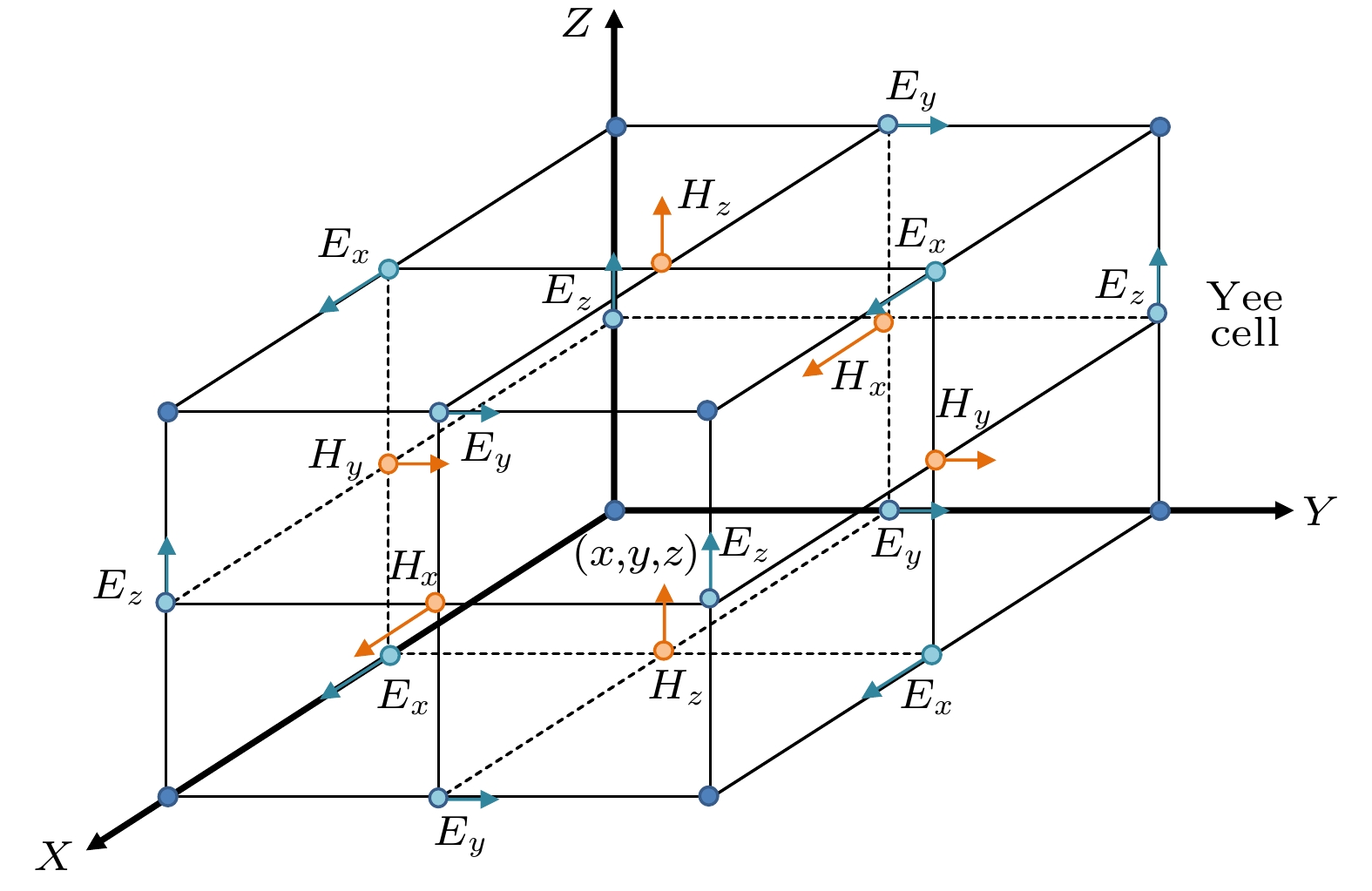
 下载:
下载:

